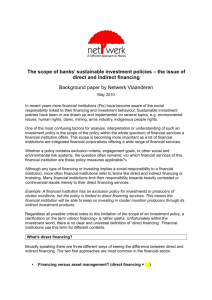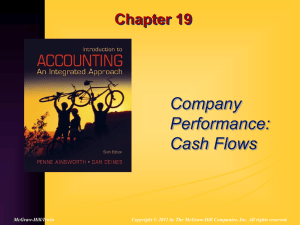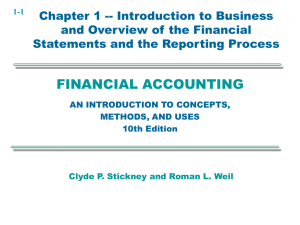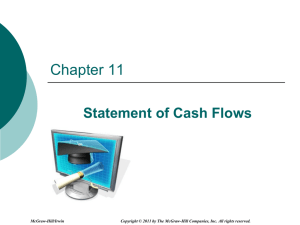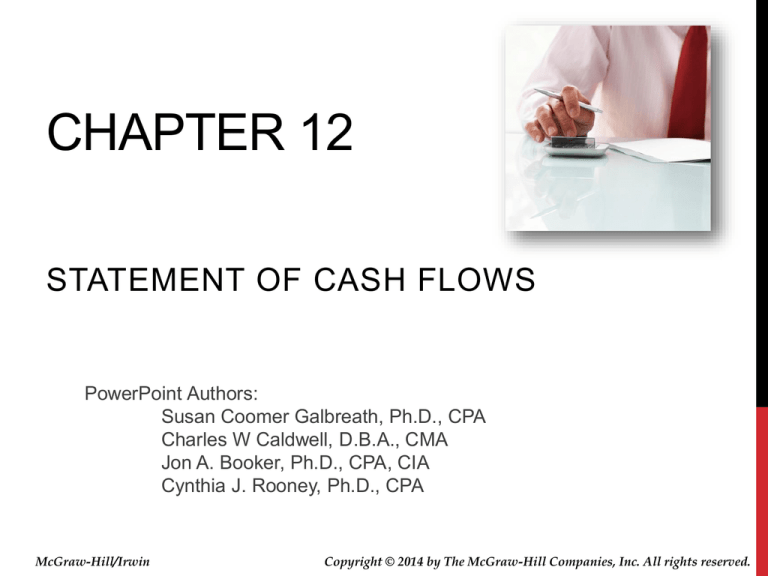
CHAPTER 12
STATEMENT OF CASH FLOWS
PowerPoint Authors:
Susan Coomer Galbreath, Ph.D., CPA
Charles W Caldwell, D.B.A., CMA
Jon A. Booker, Ph.D., CPA, CIA
Cynthia J. Rooney, Ph.D., CPA
McGraw-Hill/Irwin
Copyright © 2014 by The McGraw-Hill Companies, Inc. All rights reserved.
UNDERSTANDING THE BUSINESS
Positive cash flows permit a company to . . .
Pay
dividends to
owners.
Take advantage
of market
opportunities.
Expand its
operations.
Replace
needed assets.
Wall Street analysts consider cash flow an
important indicator of a company’s
financial health.
12-2
CLASSIFICATIONS OF THE
STATEMENT OF CASH FLOWS
Cash
Equivalents
Cash
Currency
Short-term, highly liquid investments.
Readily convertible into cash.
So near maturity that market value is unaffected by
interest rate changes (i.e., original maturities of less
than 3 months).
12-3
CLASSIFICATIONS OF THE
STATEMENT OF CASH FLOWS
Operating
Activities
Cash inflows and outflows
directly related to earnings
from normal operations.
Investing
Activities
Cash inflows and outflows related to
the acquisition or sale of productive
facilities and investments in the
securities of other companies.
Financing
Activities
Cash inflows and outflows related to
external sources of financing
(owners and creditors) for the
enterprise.
12-4
CASH INFLOWS
Operating Activities
Cash received
from revenues
Investing Activities
Sale of operational assets
Sale of investments
Collections of loans
Financing Activities
Issuance of stock
Issuance of bonds
and notes
Business
Cash paid for
expenses
Purchase of operational
assets
Purchase of investments
Loans to others
Payment of dividends
Repurchase of stock
Repayment of debt
CASH OUTFLOWS
12-5
This ending cash
balance should
agree with the
balance sheet.
12-6
DIRECT METHOD VS. INDIRECT
METHOD
Two Formats for Reporting Operating Activities
Direct Method
Indirect Method
Reports the
cash effects of
each operating
activity
Starts with
accrual net
income and
converts to
cash basis
Note that no matter which format is used, the same
amount of net cash flows from operating activities is
generated.
12-7
CASH FLOWS FROM OPERATING
ACTIVITIES
Inflows
Cash received from:
Customers
Dividends and interest on
investments
Outflows
Cash paid for:
Purchase of goods for resale
and services (electricity, etc.)
Salaries and wages
Income taxes
Interest on liabilities
+
_
Cash
Flows
from
Operating
Activities
12-8
CASH FLOWS FROM INVESTING
ACTIVITIES
Inflows
Cash received from:
Sale or disposal of property,
plant and equipment
Sale or maturity of investments
in securities
Outflows
Cash paid for:
Purchase of property, plant and
equipment
Purchase of investments in
securities
+
_
Cash
Flows
from
Investing
Activities
12-9
CASH FLOWS FROM FINANCING
ACTIVITIES
Inflows
Cash received from:
Borrowings on notes, mortgages,
bonds, etc. from creditors
+
Issuing stock to owners
Outflows
Cash paid for:
Repayment of principal to
creditors (excluding interest,
which is an operating activity)
Repurchasing stock from owners
Dividends to owners
_
Cash
Flows
from
Financing
Activities
12-10
RELATIONSHIPS TO THE BALANCE
SHEET AND THE INCOME STATEMENT
Information needed to prepare a
statement of cash flows:
Comparative Balance Sheets.
Income Statement.
Additional details concerning
selected accounts.
12-11
RELATIONSHIPS TO THE BALANCE
SHEET AND THE INCOME STATEMENT
Cash = Liabilities Stockholders’
Equity Noncash Assets
Derives from . . .
Assets = Liabilities Stockholders’ Equity
12-12
RELATIONSHIPS TO THE BALANCE
SHEET AND THE INCOME STATEMENT
12-13
REPORTING AND INTERPRETING CASH
FLOWS FROM OPERATING ACTIVITIES
The indirect method adjusts net income by eliminating
noncash items.
+/- Changes in current
assets and current
liabilities.
Net
Income
+ Losses and
- Gains
Cash Flows
from Operating
Activities:
Indirect Method
+ Noncash
expenses such as
depreciation and
amortization.
12-14
REPORTING AND INTERPRETING CASH
FLOWS FROM OPERATING ACTIVITIES
Current
Assets
Current
Liabilities
Change in Account Balance During Year
Increase
Decrease
Subtract from net
Add to net income.
income.
Add to net income.
Subtract from net
income.
Use this table when adjusting Net Income
to Operating Cash Flows using the
indirect method.
12-15
ADJUSTMENT FOR GAINS AND
LOSSES
Transactions that cause gains and losses should be
classified on the statement of cash flows as operating,
investing, or financing activities, depending on their
dominate characteristics. For example, if the sale of
equipment produced a gain, it would be classified as an
investing activity.
Gains
Gains must be subtracted from net
income to avoid double counting the
gain.
Losses
Losses must be added to net income
to avoid double counting the loss.
12-16
12-17
The Statement of Cash Flows will begin with
net income from the Income Statement.
12-18
Step 1
Adjust net income for depreciation and
amortization expense.
12-19
Step 2
Adjust net income for changes in
current assets and current liabilities.
12-20
Current
Assets
Current
Liabilities
Change in Account Balance During Year
Increase
Decrease
Subtract from net
Add to net income.
income.
Add to net income.
Subtract from net
income.
12-21
INTERPRETING CASH FLOWS FROM
OPERATING ACTIVITIES
A common rule of thumb followed by financial and credit
analysts is to avoid firms with rising net income but
falling cash flow from operations.
Investors will not invest in a company if they do
not believe that cash generated from operations
will be available to pay them dividends or expand
the company.
Creditors will not lend money if they do not believe
that cash generated from operations will be
available to pay back the loan.
12-22
INTERNATIONAL PERSPECTIVE—IFRS
CLASSIFICATION OF INTEREST ON THE CASH FLOW
STATEMENT
U.S. GAAP and IFRS differ in the cash flow statement
treatment of interest received and interest paid.
These differences are currently on the agenda of
the joint FASB/IASB financial statement
presentation project.
12-23
QUALITY OF INCOME RATIO
Quality of =
Income Ratio
Cash Flow from Operating Activities
Net Income
In general, this ratio measures the portion of
income that was generated in cash. All other
things equal, a higher quality of income ratio
indicates greater ability to finance operating
and other cash needs from
operating cash inflows.
12-24
12-25
We must report
individually the
cash used to
purchase
equipment and
the cash
proceeds
received from
the sale of
equipment.
Property, Plant, & Equipment
April 30, 2010
Purchases
Depreciation
Disposals
April 30, 2011
$
75,736
11,389
(10,771)
(77)
$ 76,277
12-26
Although shortterm
investments is
a current asset,
it is reported in
the investing
section on the
statement of
cash flows.
Short-Term Investments
April 30, 2010
Purchases
Sales
April 30, 2011
$
$
3,367
6,532
(8,406)
1,493
12-27
CAPITAL ACQUISITIONS RATIO
Capital
Acquisitions = Cash Flow from Operating Activities
Cash Paid for Property, Plant,
Ratio
and Equipment
In general, this ratio reflects the portion
of purchases of property, plant and
equipment financed from operating
activities. A high ratio indicates less
need for outside financing for current
and future expansions.
12-28
FREE CASH FLOW
Free Cash Flow = Cash Flow from Operating
Activities – Dividends – Capital Expenditures
In general, this measures a firm’s
ability to pursue long-term
investment opportunities.
12-29
REPORTING CASH FLOWS FROM
FINANCING ACTIVITIES
12-30
12-31
Cash used to
repay long-term
debt.
12-32
Cash proceeds
from the
issuance of
common stock
to employees.
12-33
Retained
earnings
decreased by
$65,560 due to
the combined
effect of
$40,754 of
income and
$106,314 in
dividends.
Retained Earnings Analysis
April 30, 2010
Add net income
Less dividends
April 30, 2011
$ 130,767
40,754
(106,314)
$ 65,207
12-34
INTERPRETING CASH FLOWS FROM
FINANCING ACTIVITIES
The long-term growth of a company is normally
financed from three sources: internally
generated funds, the issuance of stock, and
money borrowed on a long-term basis.
The statement of cash flows shows how
management has elected to fund its growth. This
information is used by analysts who wish to
evaluate the capital structure and growth
potential of a business.
12-35
COMPLETING THE STATEMENT AND
ADDITIONAL DISCLOSURES
Three Required Disclosures
1.Reconciliation of net income to cash
flow from operations
2.Noncash investing and financing
activities
3.Cash paid for interest and income
taxes
12-36
SUPPLEMENT A: REPORTING CASH FLOWS
FROM OPERATING ACTIVITIES—DIRECT
METHOD
Sales revenue
+ Decrease in accounts receivable
- Increase in accounts receivable
= Cash collected from customers
Interest/Dividend revenue
+ Decrease in interest/dividends
receivable
- Increase in interest/dividends
receivable
= Collections of interest/dividends
on investments
+
+
=
Cost of goods sold
Increase in inventory
Decrease in inventory
Increase in accounts payable
Decrease in accounts payable
Cash payments to suppliers
+
+
=
Other expenses
Increase in prepaid expenses
Decrease in prepaid expenses
Increase in accrued expenses
Decrease in accrued expenses
Cash paid for expenses
+
+
=
Income tax expense
Increase in prepaid income taxes
Decrease in prepaid income taxes
Increase in income taxes payable
Decrease in income taxes payable
Payments of income taxes
12-37
SUPPLEMENT A: REPORTING CASH FLOWS
FROM OPERATING ACTIVITIES—DIRECT
METHOD
Remember that when we prepared the
operating section using the indirect method,
we also arrived at net cash inflow of $50,425.
12-38
SUPPLEMENT B: ADJUSTMENTS FOR GAINS
AND LOSSES ON SALE OF LONG-TERM
ASSETS: INDIRECT METHOD
Property, plant, and equipment with an original cost of
$10,000 and accumulated depreciation of $4,000 is sold
for $8,000 cash.
Because the gain was included in the computation of
income, it is necessary to remove (subtract) the $2,000
gain from the Operating Activities section of the
statement to avoid double counting.
12-39
SUPPLEMENT C: T-ACCOUNT
APPROACH (INDIRECT METHOD)
Based on the idea that changes in cash must equal the sum of
the changes in all other balance sheet accounts. we can use
T-accounts to analyze cash flows as follows:
1. Prepare a single large T-account to represent the changes
that have taken place in cash, subdivided into the three
sections of the cash flow statement.
2. Prepare additional T-accounts for all noncash balance sheet
accounts, entering the beginning and ending balance in each
noncash balance sheet T-Account.
3. Enter the transactions affecting cash in each noncash
balance sheet T-account and in the proper section of the cash
T-account until all changes in noncash balance sheet
accounts have been account for.
12-40
SUPPLEMENT C: T-ACCOUNT
APPROACH (INDIRECT METHOD)
12-41
SUPPLEMENT C: T-ACCOUNT
APPROACH (INDIRECT METHOD)
12-42
END OF CHAPTER 12
12-43

